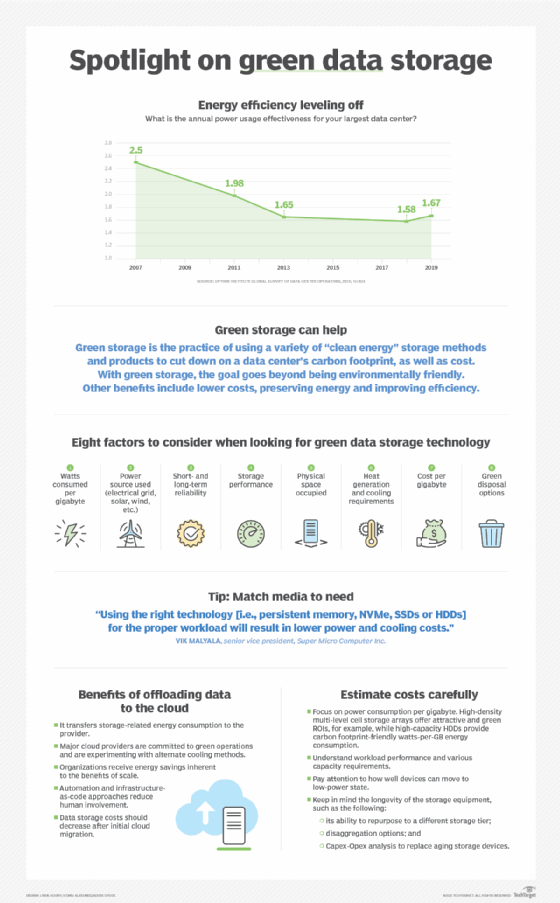Get started with green energy for your data center
Running a sustainable data center requires organizations to consider factors such as facility sustainability, efficient storage and servers, and outsourcing options.
The pressing issue of climate change requires organizations to adopt greener, more sustainable habits and technologies, especially when it comes to their data centers. Adopting greener practices and replacing outdated or inefficient technology not only cuts down on the waste data centers produce, but it also reduces the cost of running data centers.
Data centers use 1.8% of the United States' electricity and produce 0.5% of its total carbon waste. Optimizing data center power use to become more efficient and sustainable, therefore, plays a key role in reducing the country's -- and the world's -- carbon footprint. Organizations should consider various options, as there are several methods by which they can go greener.
Data center sustainability strategies
Data centers can take several steps to become more sustainable and environmentally friendly. First, data centers should focus on green facility design. Find efficient equipment that doesn't waste electricity or produce excess heat. High-efficiency uninterruptable power supplies, ultrasonic humidification and LED lighting can all reduce a data center facility's energy usage.
Next, consider green cooling strategies. Technologies such as intelligent building management systems, economizers, high-efficiency chillers, variable-frequency drives, liquid-to-chip cooling and airflow modeling can all boost the energy efficiency of a data center's cooling system.
Incorporate renewable energy sources wherever possible. Solar, wind and hydroelectric power vastly reduce an organization's carbon footprint. Certain types of renewable energy -- such as solar -- can even be harvested on site, further increasing energy efficiency and uptime.
Finally, keep an eye on water usage. In locations with a scarce water supply, using largely water-based cooling or energy generation can have an adverse effect on the local climate and biome. Data centers can support local biodiversity with careful landscaping for their facilities and by partnering with regional conservation efforts.
Transitioning to greener storage
Traditional storage technology uses a good deal of resources. However, several green data storage options exist, and organizations should consider several factors before deciding which to adopt. Using flash storage and SSDs rather than spinning disks, for example, can greatly reduce a data center's carbon emissions since they use less power and are constructed with less hazardous materials.
Offloading data to the cloud can also increase storage sustainability. Cloud suppliers usually have a higher level of CPU utilization compared to individual companies, which means they can compute more without increasing power consumption. Cloud also relies heavily on automation and infrastructure-as-code, which cuts down on human error and opportunities for energy waste.
When evaluating green storage options, focus on power consumption per gigabyte.

AI for sustainability initiatives
Organizations can implement AI and automation for their green initiatives. AI can analyze utility consumption data and optimize energy usage and cost, which then enables organizations to mitigate waste around processes such as cooling. For example, Google developed an AI algorithm that automatically manages and reconfigures data center cooling based on temperature and energy data it collects.
However, AI systems can be demanding. Although they might help with certain sustainability efforts and efficiency processes, be sure to weigh the cost of their implementation against their possible benefits first.
Green cloud computing
Several vendors aim to assist organizations in their sustainability goals, particularly when it comes to cloud adoption. Accenture has released Green Cloud Advisor, a tool designed to recommend cloud deployment approaches based on a customer's energy consumption and green characteristics of public cloud offerings. Thoughtworks offers Cloud Carbon Footprint, an open source tool that estimates carbon emissions from memory and networking in the cloud.
Many cloud providers themselves have also implemented greener initiatives. Organizations seeking a green cloud optimization strategy can assess their cloud sustainability while accounting for the financial and environmental cost of a cross-border data migration strategy.
Data center sustainability certifications
An organization can certify its data center facility's sustainability with the LEED program. The U.S. Green Building Council developed the Leadership in Energy and Environmental Design (LEED) program as a guideline to create more environmentally friendly, cost-effective green buildings. LEED certifies buildings at four levels -- Platinum, Gold, Silver and Certified -- which correspond to how many points a building receives during the certification process. Points are accrued through various features and optimizations, such as optimizing energy performance as it relates to carbon emissions.
Organizations can apply for a LEED certification either by optimizing the operations in their existing facilities, or by building new sustainable data center facilities. Data centers qualify by having clear energy efficiency management practices, cooling management protocols for HVAC systems and air quality, indoor lighting controls that meet illumination and lighting load requirements, and plans to address environmental performance levels.






